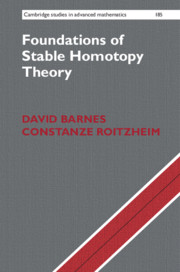Book contents
- Frontmatter
- Contents
- Introduction
- 1 Basics of Stable Homotopy Theory
- 2 Sequential Spectra and the Stable Homotopy Category
- 3 The Suspension and Loop Functors
- 4 Triangulated Categories
- 5 Modern Categories of Spectra
- 6 Monoidal Structures
- 7 Left Bousfield Localisation
- Appendix Model Categories
- References
- Index
6 - Monoidal Structures
Published online by Cambridge University Press: 09 March 2020
- Frontmatter
- Contents
- Introduction
- 1 Basics of Stable Homotopy Theory
- 2 Sequential Spectra and the Stable Homotopy Category
- 3 The Suspension and Loop Functors
- 4 Triangulated Categories
- 5 Modern Categories of Spectra
- 6 Monoidal Structures
- 7 Left Bousfield Localisation
- Appendix Model Categories
- References
- Index
Summary
Bousfield localisation, or more specifically, left Bousfield localisation, is an established tool to formally add more weak equivalences to a model category. The most common setting is localisation of spaces or spectra with respect to a homology theory: rather than the weak equivalences being isomorphisms of homotopy groups, one constructs a model structure with the homology isomorphisms as the weak equivalences. As a consequence, the homology isomorphisms become strict isomorphisms in the corresponding homotopy category. Therefore, we can think of Bousfield localisation as a good formal framework for inverting maps in the homotopy category. Typically, information is lost in this process, but some specific aspects may stand out clearer after localisation. We will see an example of this behaviour in the final section when we show that the p-local stable homotopy category has vast computational advantages over working with the stable homotopy category itself. We will also see how Bousfield localisation can help us gain insight into the deeper structure of the stable homotopy category via p-localisation, p-completion, K-theory and chromatic homotopy theory.
Keywords
Information
- Type
- Chapter
- Information
- Foundations of Stable Homotopy Theory , pp. 234 - 316Publisher: Cambridge University PressPrint publication year: 2020
